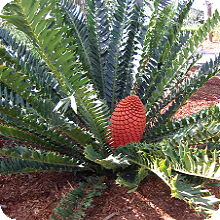|
| Division: Cycadophyta |
| Class: Cycadopsida |
| Order: Cycadales |
| Family: Zamiaceae |
| Genus: Encephalartos |
| Species: E. ferox |
Conservation Status: |

E. ferox
Maputaland CycadEncephalartos ferox is a small cycad with 35 cm wide subterranean trunk. It gets its name from the Latin word ferocious, likely from the spine-tipped lobes on the leaves of the plant. It is found naturally on the south-eastern coast of Africa where it has been used by local people for its starch content. It is considered to be one of the most popular cultivated cycads. It is also known as the Maputaland cycad, Zululand cycad, Tongaland cycad (Eng.), Maputalandbroodboom, Tongalandbroodboom (Afr.), umthobane, uthobani (Zulu), chihanga (Thonga).
The trunk is often subterranean, and can grow up to a meter in length. Its roots contract due to the collapse of transverse sheets of cells in the cortex. It is thought that this contraction can help prevent seedlings from desiccation as they develop. The leaves are pinnately compound and can grow up to two meters long. They are typically hard-textured, and green. Young leaves are described as being hairy, and ranging from dark green to coppery brown in color. Each leaflet is about 15 cm long and about 3.5 to 5 cm wide. The leaflets can be flat or twisted, and are usually broad with spine-tipped lobes. They are inserted at about 70° on the rhachis.
Cultivation:
Encephalartos ferox is popular in gardens and in the horticultural trade and is one of the more commonly available cycad species available in nurseries. It grows best in partial shade and require plenty of water. It is not tolerant of very severe frost.
This species may be propagated from seeds or by the removal of offsets or suckers. In order for pollination to occur, it is essential to have both male and female plants in cone at the same time. Although pollination does occur naturally in the wild where populations are larger, pollination must be done artificially in a garden environment. The pollen needs to be collected from the male plants and may be stored in a freezer for many months. When the female cones are ready to receive pollen the cone scales open ever so slightly. Hand pollination can then be done by washing the pollen mixed with distilled water into the female cone.
Although seeds will always be produced by female cones, they will only be viable and germinate if they have been successfully pollinated. To determine if the seeds are fertile - remove the fleshy covering by soaking them in water for 2-3 days and then rubbing it off. Then put seeds in a bucket filled with water … the heavier fertile seeds will sink to the bottom and the infertile seeds will float on top.
The embryo develops in the seed immediately following fertilisation but it will take 6-7 months until it is ready to germinate. During this time, the cleaned seeds may be stored in a dry cupboard. Once the seed germinates, a tuberous tap root is immediately formed and once established, the first leaf will emerge. This is about 6 weeks after the emergence of the root.
| shade | dark green | low watering | fast growth | frost-sensitive | common |
Encephalartos ferox is popular in gardens and in the horticultural trade and is one of the more commonly available cycad species available in nurseries. It grows best in partial shade and require plenty of water. It is not tolerant of very severe frost.
This species may be propagated from seeds or by the removal of offsets or suckers. In order for pollination to occur, it is essential to have both male and female plants in cone at the same time. Although pollination does occur naturally in the wild where populations are larger, pollination must be done artificially in a garden environment. The pollen needs to be collected from the male plants and may be stored in a freezer for many months. When the female cones are ready to receive pollen the cone scales open ever so slightly. Hand pollination can then be done by washing the pollen mixed with distilled water into the female cone.
Although seeds will always be produced by female cones, they will only be viable and germinate if they have been successfully pollinated. To determine if the seeds are fertile - remove the fleshy covering by soaking them in water for 2-3 days and then rubbing it off. Then put seeds in a bucket filled with water … the heavier fertile seeds will sink to the bottom and the infertile seeds will float on top.
The embryo develops in the seed immediately following fertilisation but it will take 6-7 months until it is ready to germinate. During this time, the cleaned seeds may be stored in a dry cupboard. Once the seed germinates, a tuberous tap root is immediately formed and once established, the first leaf will emerge. This is about 6 weeks after the emergence of the root.
E. ferox for sale at AfricaCycads.com:
